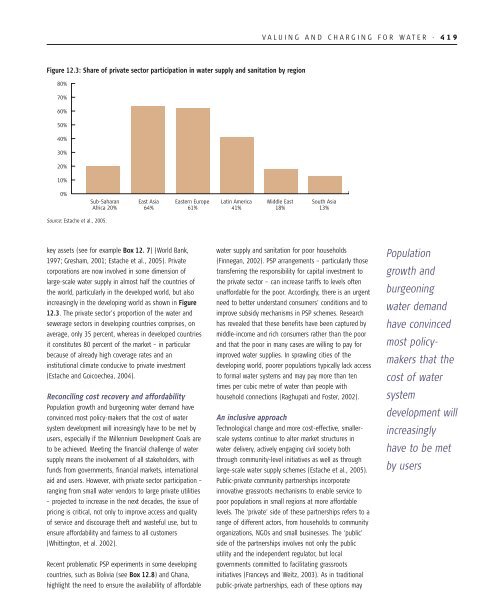Water: a shared responsibility; 2006 - UN-Water
Water: a shared responsibility; 2006 - UN-Water
Water: a shared responsibility; 2006 - UN-Water
Create successful ePaper yourself
Turn your PDF publications into a flip-book with our unique Google optimized e-Paper software.
V A L U I N G A N D C H A R G I N G F O R W A T E R . 419<br />
Figure 12.3: Share of private sector participation in water supply and sanitation by region<br />
80%<br />
70%<br />
60%<br />
50%<br />
40%<br />
30%<br />
20%<br />
10%<br />
0%<br />
Sub-Saharan<br />
Africa 20%<br />
East Asia<br />
64%<br />
Eastern Europe<br />
61%<br />
Latin America<br />
41%<br />
Middle East<br />
18%<br />
South Asia<br />
13%<br />
Source: Estache et al., 2005.<br />
key assets (see for example Box 12. 7) (World Bank,<br />
1997; Gresham, 2001; Estache et al., 2005). Private<br />
corporations are now involved in some dimension of<br />
large-scale water supply in almost half the countries of<br />
the world, particularly in the developed world, but also<br />
increasingly in the developing world as shown in Figure<br />
12.3. The private sector’s proportion of the water and<br />
sewerage sectors in developing countries comprises, on<br />
average, only 35 percent, whereas in developed countries<br />
it constitutes 80 percent of the market – in particular<br />
because of already high coverage rates and an<br />
institutional climate conducive to private investment<br />
(Estache and Goicoechea, 2004).<br />
Reconciling cost recovery and affordability<br />
Population growth and burgeoning water demand have<br />
convinced most policy-makers that the cost of water<br />
system development will increasingly have to be met by<br />
users, especially if the Millennium Development Goals are<br />
to be achieved. Meeting the financial challenge of water<br />
supply means the involvement of all stakeholders, with<br />
funds from governments, financial markets, international<br />
aid and users. However, with private sector participation –<br />
ranging from small water vendors to large private utilities<br />
– projected to increase in the next decades, the issue of<br />
pricing is critical, not only to improve access and quality<br />
of service and discourage theft and wasteful use, but to<br />
ensure affordability and fairness to all customers<br />
(Whittington, et al. 2002).<br />
Recent problematic PSP experiments in some developing<br />
countries, such as Bolivia (see Box 12.8) and Ghana,<br />
highlight the need to ensure the availability of affordable<br />
water supply and sanitation for poor households<br />
(Finnegan, 2002). PSP arrangements – particularly those<br />
transferring the <strong>responsibility</strong> for capital investment to<br />
the private sector – can increase tariffs to levels often<br />
unaffordable for the poor. Accordingly, there is an urgent<br />
need to better understand consumers’ conditions and to<br />
improve subsidy mechanisms in PSP schemes. Research<br />
has revealed that these benefits have been captured by<br />
middle-income and rich consumers rather than the poor<br />
and that the poor in many cases are willing to pay for<br />
improved water supplies. In sprawling cities of the<br />
developing world, poorer populations typically lack access<br />
to formal water systems and may pay more than ten<br />
times per cubic metre of water than people with<br />
household connections (Raghupati and Foster, 2002).<br />
An inclusive approach<br />
Technological change and more cost-effective, smallerscale<br />
systems continue to alter market structures in<br />
water delivery, actively engaging civil society both<br />
through community-level initiatives as well as through<br />
large-scale water supply schemes (Estache et al., 2005).<br />
Public-private community partnerships incorporate<br />
innovative grassroots mechanisms to enable service to<br />
poor populations in small regions at more affordable<br />
levels. The ‘private’ side of these partnerships refers to a<br />
range of different actors, from households to community<br />
organizations, NGOs and small businesses. The ‘public’<br />
side of the partnerships involves not only the public<br />
utility and the independent regulator, but local<br />
governments committed to facilitating grassroots<br />
initiatives (Franceys and Weitz, 2003). As in traditional<br />
public-private partnerships, each of these options may<br />
Population<br />
growth and<br />
burgeoning<br />
water demand<br />
have convinced<br />
most policymakers<br />
that the<br />
cost of water<br />
system<br />
development will<br />
increasingly<br />
have to be met<br />
by users
















